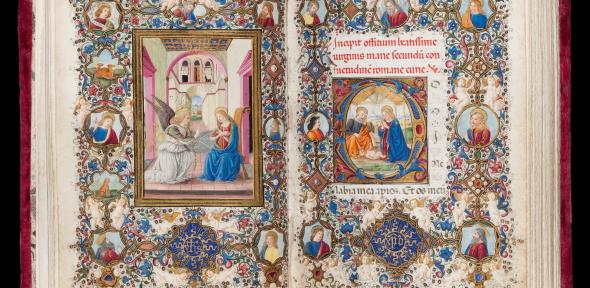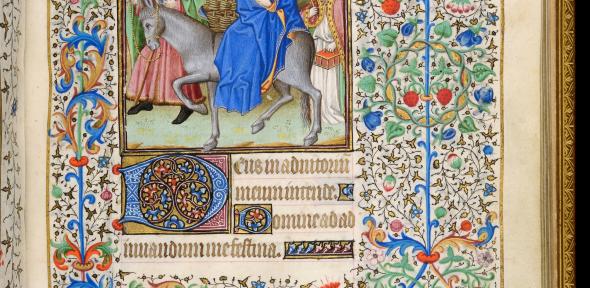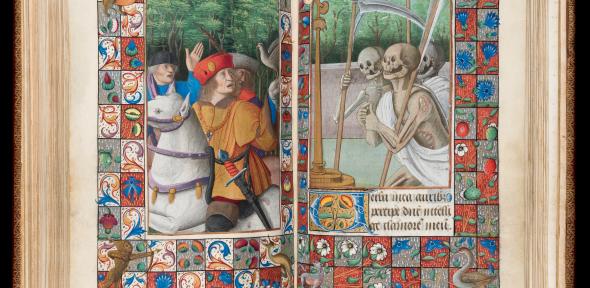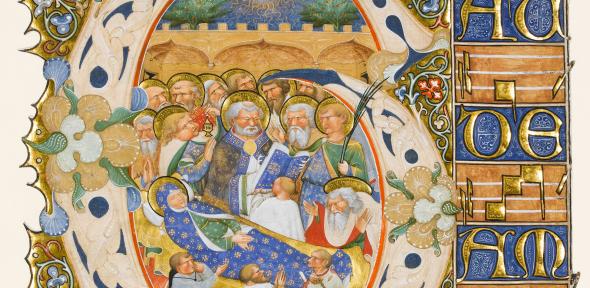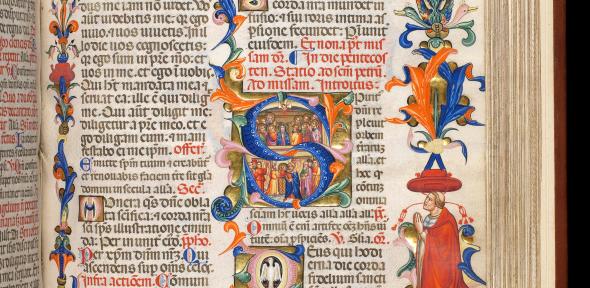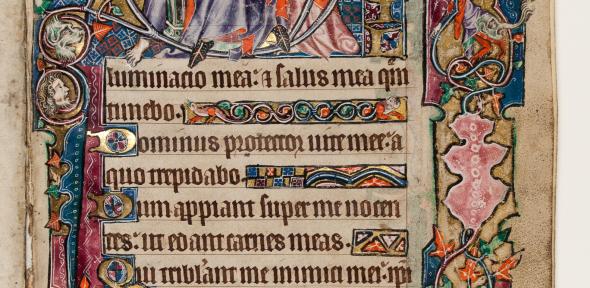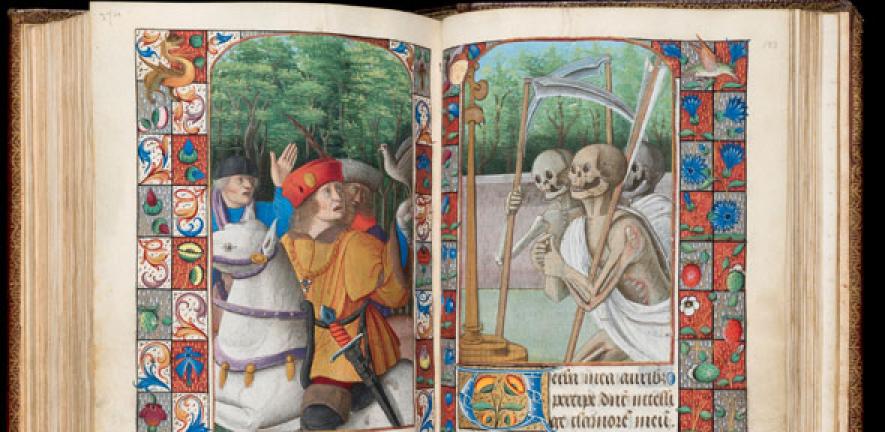
Some of the finest illuminated manuscripts in the world – treasures combining gold and precious pigments – will go on display today in celebration of the Fitzwilliam Museum’s bicentenary.
Some of the finest illuminated manuscripts in the world – treasures combining gold and precious pigments – will go on display today in celebration of the Fitzwilliam Museum’s bicentenary.
Leading artists of the Middle Ages and early Renaissance did not think of art and science as opposing disciplines.
Stella Panayotova
The majority of the exhibits are from the Museum’s own rich collections, and those from the founding bequest of Viscount Fitzwilliam in 1816 can never leave the building and can only be seen at the Museum. For the first time, the secrets of master illuminators and the sketches hidden beneath the paintings will be revealed in a major exhibition presenting new art historical and scientific research.
Spanning the 8th to the 17th centuries, the 150 manuscripts and fragments in COLOUR: The Art and Science of Illuminated Manuscripts guide us on a journey through time, stopping at leading artistic centres of medieval and Renaissance Europe. Exhibits highlight the incredible diversity of the Fitzwilliam’s collection: including local treasures, such as the Macclesfield Psalter made in East Anglia c.1330-1340, a leaf with a self-portrait made by the Oxford illuminator William de Brailes c.1230-1250, and a medieval encyclopaedia made in Paris c.1414 for the Duke of Savoy.
Four years of cutting-edge scientific analysis and discoveries made at the Fitzwilliam have traced the creative process from the illuminators’ original ideas through their choice of pigments and painting techniques to the completed masterpieces.
“Leading artists of the Middle Ages and early Renaissance did not think of art and science as opposing disciplines,” said curator, Dr Stella Panayotova, Keeper of Manuscripts and Printed Books. “Instead, drawing on diverse sources of knowledge, they conducted experiments with materials and techniques to create beautiful works that still fascinate us today.”
Merging art and science, COLOUR shares the research of MINIARE (Manuscript Illumination: Non-Invasive Analysis, Research and Expertise), an innovative project based at the Fitzwilliam. Collaborating with scholars from the University of Cambridge and international experts, the Museum’s curators, scientists and conservators have employed pioneering analytical techniques to identify the materials and methods used by illuminators.
“This has been an exciting project,” said research scientist, Dr Paola Ricciardi. “By combining imaging and spectroscopic analysis — methods more commonly associated with remote sensing and analytical chemistry — and by exploring such a diverse range of manuscripts, we can begin to understand how illuminators actually worked.”
“A popular misconception is that all manuscripts were made by monks and contained religious texts, but from the 11th century onwards professional scribes and artists were increasingly involved in a thriving book trade, producing both religious and secular texts. Scientific examination has revealed that illuminators sometimes made use of materials associated with other media, such as egg yolk, which was traditionally used as a binder by panel painters.”
Other discoveries include pigments rarely associated with manuscript illumination – such as the first ever example of smalt detected in a Venetian manuscript. Smalt, obtained by grinding blue glass, was found in a Venetian illumination book made c.1420. Evidently, the artist who painted it had close links with the famed glassmakers of Murano. This example predates by half a century the documented use of smalt in Venetian easel paintings.
Analyses of sketches lying beneath the paint surfaces, and of later additions and changes to paintings help to shed light on manuscripts and their owners. One French prayer book, made c.1430, was adapted over three generations to reflect the personal circumstances and dynastic anxieties of a succession of aristocratic women.
Adam and Eve were originally shown naked in an ABC commissioned c.1505 by the French Queen, Anne of Brittany (1476-1514) for her five-year-old daughter. However, a later owner, offended by the nudity, gave Eve a veil and Adam a skirt. Infrared imaging techniques and mathematical modelling have made it possible to reconstruct the original composition without harming the manuscript.
The Museum’s treasures will be displayed alongside carefully selected loans — celebrated manuscripts from Cambridge libraries as well as other institutions in the UK and overseas. These include an 8th century Gospel Book from Corpus Christi College, the University Library’s famous Life of Edward the Confessor, magnificent Apocalypses from Trinity College and Lambeth Palace, London, and a unique model book from Göttingen University.
Visitors will be encouraged to make their own discoveries in the exhibition galleries and online through a new, free digital resource: ILLUMINATED: Manuscripts in the Making. With hundreds of high resolution digital images and infrared photographs, this interactive, cross-disciplinary resource offers users in-depth information on the manuscripts’ contents, patrons, cultural and historical contexts, as well as scientific data relating to artists’ techniques and materials.
With over 300 illustrations in full colour, the authoritative exhibition catalogue encompasses subjects as diverse as the trade in pigments, painting techniques, the medieval science of optics and modern-day forgeries. Catalogue entries and essays by leading experts offer readers insight into all aspects of colour from the practical application of pigments to its symbolic meaning.
“We are delighted to be presenting this exhibition in our bicentenary year,” said director, Tim Knox. “Ten years ago The Cambridge Illuminations was the Museum’s first ever record-breaking exhibition, attracting over 80,000 visitors. People were enchanted by the remarkable beauty and delicacy of the manuscripts. I am convinced that our bicentenary visitors will again be equally inspired by the superb illuminations collected and treasured at the Fitzwilliam for 200 years, and will value this rare opportunity to find out how they were made and how we are preserving them for the future.”
COLOUR: The Art and Science of Illuminated Manuscripts will run during the second half of the Fitzwilliam’s bicentenary year, from 30 July to 30 December 2016. Admission is free.

The text in this work is licensed under a Creative Commons Attribution 4.0 International License. For image use please see separate credits above.

